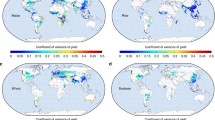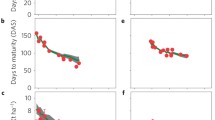Abstract
Historical grain yields from several countries were analyzed to determine the variability of grain yield. This was accomplished by assuming a linear technology trend and analyzing the deviations from this trend. The deviation was assumed to be primarily an effect of weather. Using 10 percent deviation from trend as a threshold, it was determined that for each of seven countries the probability of a poor yield year ranged from 17 in India and the United States to 33 percent in Canada and the U.S.S.R. The probability of two consecutive poor wheat yield years was highest in Canada (17 percent) and lowest in Argentina (6 percent). The probability of a poor year occurring in the same year in both the United States and the U.S.S.R. was about 7–8 percent. The highest variability in yield has occurred in Canada, but variability in India has increased substantially since the 1960's.
Similar content being viewed by others
References
McQuigg, J. D.: ‘Climatic variability and the world food situation’, Environmental Data Service, July 1974, pp. 3–7.
Steyaert, L. T., LeDuc, S. K., and McQuigg, J. D.: 1978, ‘Atmospheric pressure and yield modeling’, Agricultural Meteorology 19, 23–24.
Mitchell, J. M., Jr., Stockton, C. W., and Meko, D. M.: 1979, ‘Evidence of a 22 year rhythm of a drought in the Western United States related to Hale solar cycle since the 17th Century’, Proceedings of the Ohio State Symposium - Workshop on Solar-Terrestrial Influences on Weather and Climate, D. Reidel Publishing Co., Holland.
Spangler, W. M., and Jenne, R. L.: ‘World monthly surface station climatology’, Data Tape at National Center for Atmospheric Research, November 1977.
World Meteorological Organization Technical Note 61: 1964, ‘Note on the standardization of pressure reduction methods in the international network of synoptic stations’.
World Meteorological Organization Technical Note 91: 1968, ‘Methods in use for the reduction of atmospheric pressure’.
Davitaya, F. F., and Sapozhnikova, S. A.: 1969, ‘Agroclimatic studies in the U.S.S.R.’, Bulletin of the American Meteorological Society 50, 67–74.
Kogan, F. N.: 1977, ‘Weather, crop management, and variability of grain yields’, Meteorologiya i Gidrologia 7, 74–82.
Angus, J. F., and Dixon, M. E.: ‘Weather and yield in two wheat-growing regions in Australia’, Report to the Department of Consumer Affairs, Canberra, A.C.T., September 1975.
Sakamoto, C. M.: 1977, ‘The Z-index and subitaneous events as variables for estimating wheat yield in Argentina’, LACIE-00503, NASA, Lyndon B. Johnson Space Center, Houston, Texas.
Bond, J. J., and Umberger, D. E.: 1978, ‘Technical and economic causes of productivity changes in U.S. wheat productivity, 1949–1976’, U.S. Department of Agriculture Technical Bulletin 1598.
Author information
Authors and Affiliations
Rights and permissions
About this article
Cite this article
Sakamoto, C., Leduc, S., Strommen, N. et al. Climate and global grain yield variability. Climatic Change 2, 349–361 (1980). https://doi.org/10.1007/BF00137204
Received:
Revised:
Issue Date:
DOI: https://doi.org/10.1007/BF00137204




